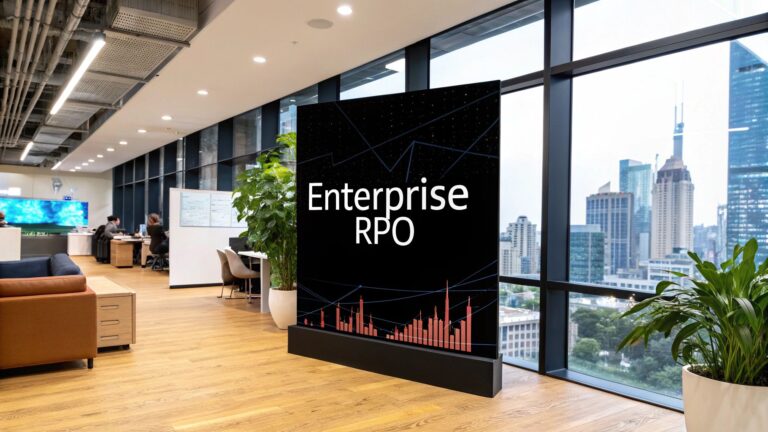Introduction
It is crucial to prioritise roles, have relevant forecasts, streamline communication, and conduct proper talent analysis during a hiring ramp. Taggd helps businesses find this right match.
Hiring Ramp is like a 100mts race. Just like every millisecond counts in a 100mt race, every day’s progress is crucial during a hiring ramp A smarter move is to work with a Recruitment Process Outsourcing (RPO) partner who already has market-mapping information available to get you off the blocks quickly.

Hiring Ramp
Picture this; you are going about your regular business at your workplace when the phone rings. It’s for an urgent out-of-line request. Your company’s hiring freeze has ended, and new business is pouring in, which calls for an immediate ramp-up. If you are like most people, it will probably be to start worrying about what you can say to buy more time! Eventually, however, you will have to start planning to hire 400 people. Now time is of the essence. Hiring Ramp is like a 100mts race. Just like every millisecond counts in a 100mt race, every day’s progress is crucial during a hiring ramp — you need to be as efficient as possible. A good start is very important else you’re playing catchup the whole race. A good start is the need of the hour, and here are the four steps that will make a power-packed start possible.
Step 1 – Pritoitise
In a hiring ramp, it extremely important to priortise roles in order to allocate your resources and time judiciously. For instance, suppose you have to manage 400 hires for 36 roles in 4 months. All your hiring requirements might not share the same degree of importance. Some will have a bigger and more immediate impact on the business than others which makes prioritisation one of the most important tasks. The best way to go about prioritizing roles is to tag all the 36 roles in as per volume and business importance as shown and then further enhancing the roles by understanding the business implications of not filling these roles.
Step 2: Funnel & Forecast
In all probability, the business functions would be unaware of the enormity of the task that lies ahead. The key is breaking down the conversion process to determine the effort needed in each step of the funnel. You must understand the overall goal of getting 400 hires is made up of a series of micro-conversions. In the stated example, creating a funnel for 400 hires essentially means that you need to reach out to about 4800 candidates through focus sourcing. Assuming 2880 candidates make it through your screening criteria and are sent for hiring manager evaluation, now imagine, the hiring managers shortlist 5 candidates from every 8 CV shared for an interview, which makes it 1800 candidates eligible for the interview process and 1800 hours of the interview. Finally, you roll out offers to about 600 candidates keeping a buffer for dropouts. You can use existing industry average ratios or your data as per the role/industry/seniority/etc. to arrive at the total number of candidates you need to source, screen, interview, in order to reach the intended joining numbers.
Step 3: Debriefing with Hiring Managers & collaborating with them
You will need the support and availability of hiring managers to ensure successful hiring. Hiring managers are best suited to share insights on talent requirements – technical skills, soft skills, their expectations from candidates, etc. which will help you in efficient screening. Moreover, the funneled numbers in step 2 will help you estimate the time you and your team need from the hiring manager to discuss the JDs/requirements in the initial stage and then the time needed to align interviews with them as you move to phase 2 of hiring ramp. The unavailability of a hiring manager panel is by far one of the biggest challenges in the timely completion of ramps. It is thus important for you to have this conversation and collaborate for the best results
Step 4: Deep Dive into Roles
We at Taggd firmly believe that a JD or mandate may or may not be very different from your competition. It does not give the required clarity on the selection or the hiring criteria. At Taggd we arrive at the same by establishing the CTQ parameters. This is done by getting inputs from hiring manager along with good hold of relevant industry data such as such as location spread of available talent, experience range, notice period, and compensation, availability of the potential candidate, candidate expectation and etc. The above-mentioned talent analysis and talent mapping involve plenty of back-end work. The initial effort can be time-consuming if you do not have the required data. A smarter move is to work with Recruitment Process Outsourcing or RPO companies who already has market-mapping information available to get you off the blocks quickly. At Taggd, we have been helping businesses across sectors find the right match. If you are interested to learn more, you can reach out to us at +91 9560203631 or visit our case study section.
About Taggd
Taggd is a AI recruitment platform that provides ready-to-hire talent to most of India Inc. Covering 14+ sectors and having onboarded 100+ clients, Taggd manages permanent recruitment for over half a million jobs. In just 13 years, Taggd has developed in-depth industry knowledge and recruitment expertise, establishing a talent network through digital intelligence. For businesses, Taggd offers access to a robust tech stack that complements business operations.







